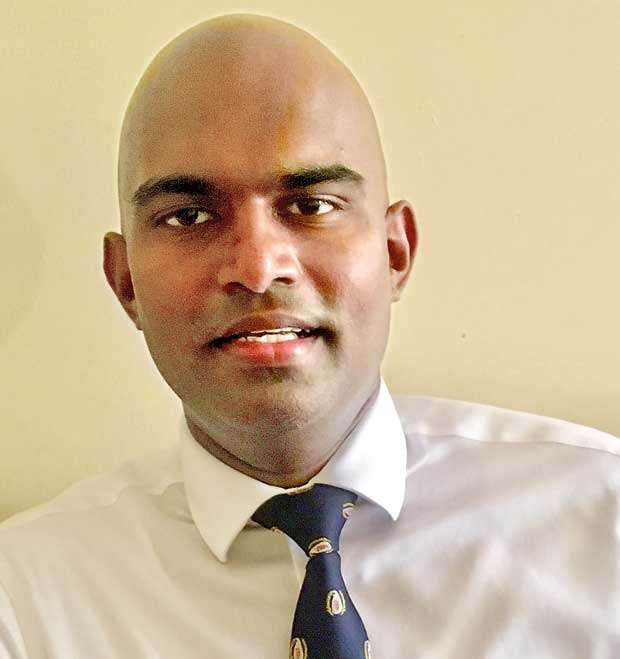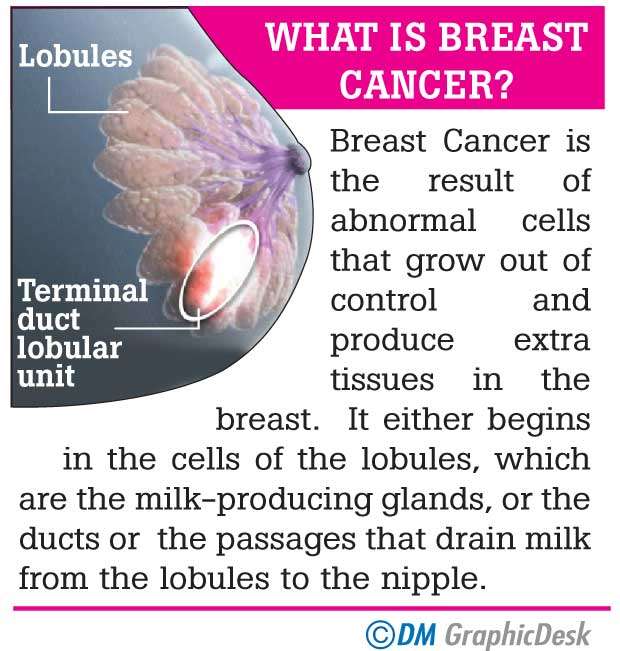15 Nov 2018 - {{hitsCtrl.values.hits}}
As per the World Health Organisation, survival rates are as high as 80% in the developed world

Dr. Randima Nanayakkara, Consultant in Surgical Oncology, discusses why awareness is of critical importance in battling the most common cancer among women.
October is the month dedicated to breast cancer awareness worldwide.
The importance of promoting awareness is clear when we examine some startling breast cancer statistics, between the developing and developed countries. As per the World Health Organisation, survival rates are as high as 80% in the developed world, where established state sponsored screening programmes and heightened awareness of the disease exist. In comparison the rate is as low as 40% in the developing world where such awareness levels do not exist. In Sri Lanka breast cancer is today the commonest cancer in females. As per the data reported in 2010 by the Ministry of Health, the incidence was around 18 cases for every 100,000 persons and the general consensus is that this figure has been on a steady rise since then.
Thus explaining the significance of marking a month dedicated to awareness, Dr. Nanayakkara explains that “as the number one cancer affecting women, the disease has attracted millions of dollars in research funding worldwide and this has been so for over decades. It is also a matter of high importance for the health care profession in Sri Lanka. The result is that today, the treatment of the disease follows a very streamlined and meticulous approach and the rates of success if detected early and treated without an undue delay are very promising. Sri Lanka is yet to implement a far reaching breast cancer screening programme in the country, the lack of which is certainly a disadvantage. However, this is where initiatives taken by the private, public and NGO sector such as the work done during the breast cancer awareness month of October play an important role”.
Dr. Nanayakkara’s observation is that most of the female patients he treats seem to present their case too late for curative treatment. He believes this can be attributed to the fact that most frequently the clinical symptom the patient encounters is a painless lump which slowly grows in size over months. In about 10% of the cases the lump results in only a mild pain. Therefore, patients sense no urgency in investigating these lumps. However as early detection is the key to successfully treating the disease, the ignorance and inaction of the typical cancer patient stands as a huge disadvantage to them in fighting the disease.
Dr. Nanayakkara further noted that “There is also the apprehension and fear people feel about what is to follow should the lump in fact be cancerous. It is an irrational yet understandable feeling of fear which we as doctors encounter every day with patients we treat” he explains. This is why a discussion about breast cancer detection and diagnosis would be of utmost importance.
It is usually a panel of doctors comprising of an Oncologist, Radiologist, Pathologist and an Oncological Surgeon who will discuss a treatment plan for a given patient
As Dr. Nanayakkara outlines, a first stop for a female suspecting a cancerous lump is at a General Medical Practitioner who is trained to conduct a preliminary breast examination. Thereafter the patient will be referred to a surgical oncologist/ surgeon who will initiate what is referred to as the “triple assessment” Any breast lump irrespective of the patient’s age should be investigated via the triple assessment the aim of which is to establish if the lump in question is benign or malignant.
Step one of this assessment is the clinical examination where the patient’s history is discussed with an Oncological Surgeon and a physical examination of the patient occurs. The Second step involves radiological imaging where a non-invasive ultra sound scan will be done. Depending on the age and specific needs of the case, a mammogram and/or a MRI scan will also be warranted. The third stage is a fine needle biopsy which is a study of the cells obtained from the lump. The procedure is a simple out-patient procedure done under local anaesthesia. The above mentioned triple assessment can diagnose a cancer with about a 97% accuracy level.

Following the triple assessment, and if the result suggests a breast cancer, a core biopsy will be required for the final confirmatory diagnosis. Here a slightly larger needle will obtain a larger sample of tissue for analysis. This too is an out-patient procedure done under local anaesthesia.
As cost is also a cause for apprehension, Dr. Nanayakkara highlights that the cost of the triple assessment is around Rs. 15,000 to Rs. 20,000 in the private sector. The cost of a core biopsy is also around Rs. 15,000. Of course, via the public health service all of this comes free of charge.
Following the confirmation that it is indeed breast cancer that a patient is diseased of, it is usually a panel of doctors comprising of an Oncologist, Radiologist, Pathologist and an Oncological Surgeon who will discuss a treatment plan for a given patient. While surgery is usually the first step in the treatment of an early stage breast cancer, a combination of chemotherapy, radiotherapy, surgery and or hormone therapy may be offered for patients with more advanced disease.
As a surgical oncologist Dr. Nanayakkara who carries out regular breast conservation and reconstruction surgeries, he highlights that breast cancer removal surgery today is less radical and less disfiguring than in previous times. The general idea is to provide a greater degree of normalcy for the patient following the surgery. Breast conservation surgery removes a tumour along with a rim of normal breast tissue leaving the original breast largely intact. On the other hand, breast reconstruction involves recreating a breast following a removal of a breast, using muscle tissue from other parts of a patient’s body or artificial implants. Conservation and reconstruction both are practised by a few surgeons even in Sri Lanka and apart from being effective in removing all traces of cancer from the affected breasts it proves to provide a lesser psychological impact on the patient post recovery.
The message during the month of awareness is clear. It is a call to women to be more breast-aware. A self-breast examination every month following the completion of the monthly menstrual cycle is a simple first step in the right direction. Seeking urgent medical attention if there is any change in a breast from what is considered normal is a must. Consider changes in the appearance in the breast, feelings of discomfort, lumps and nipple discharges as tell-tale signs of some underlying problem. Breast cancer is a surmountable challenge.
30 Nov 2024 2 hours ago
30 Nov 2024 4 hours ago
30 Nov 2024 4 hours ago
30 Nov 2024 6 hours ago
30 Nov 2024 9 hours ago